ECAL
From Themarshallwiki
| Estados Confederados de America Latina America Latina Confederate States of Latin America Latin America | |
| | |
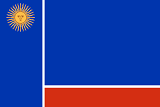 | 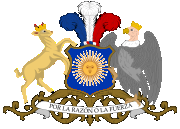
|
| Flag | Coat of arms |
| | |
| Anthem America Latina Delantera! | |
| | |
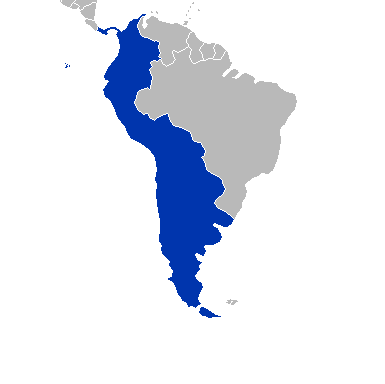
| |
| | |
| Capital Largest city | Santiago de Chile 33o26'0"S, 70o40'0"W Buenos Aires |
| | |
| Official languages | Spanish |
| | |
| Government - President | Constitutional federal republic Michelle Bachelet |
| | |
| Establishment - Indpendence and union | 1950 |
| | |
| Area - Total - Water (%) | 7,977,756 km2 3,085,391 sq mi 2.24 |
| | |
| Population - July 2008 est. - Density | 168,103,307 21/km2 54.5/sq mi |
| | |
| GDP - Total - Per capita | 2009 estimate $2.9 trillion $17,621 |
| | |
| Gini | 36.7 (medium) |
| | |
| HDI | 0.987 (high) |
| | |
| Currency | ECAL Peso (LAP)
|
| | |
| Time zone - Summer (DST) | (UTC -5 to -3) (UTC -4 to -2) |
| | |
| Internet TLD | .al |
| | |
| Calling code | +94 |
The Confederate States of Latin America (Estados Confederados de America Latina, or ECAL) is a federal republic comprising all of the Spainish speaking nations of South America (except Venezuela) plus Panama. It consists of the following states:
 Argentina
Argentina
 Bolivia
Bolivia
 Chile
Chile
 Colombia
Colombia
 Ecuador
Ecuador
 Panama
Panama
 Paraguay
Paraguay
 Peru
Peru
 Uruguay
Uruguay
There is also a Federal Territory, the Santiago Federal Territory, which is the seat of the Federal Government.
Contents |
History
Foundation
The ECAL was founded as a result of the Santiago Conference of 1946. In this conference, the leaders of the Spanish-speaking South American nations, plus Panama discussed the future of Hispanic South America. With the exception of Venezuela, all the nations decided on a Confederation.
In 1947, the Santiago Acuerdo (Santiago Agreement) was signed by the participants (excluding Venezuela). In 1947, the Convencion Constitucional met in Buenos Aires to consider a Constitution.
The requirement set under the Acuerdo was that all the state governments should agree to it before it came into force, and that it be put to the people. The requirement for victory was a majority of voters in at least 6 states.
The referendum passed in all states in 1949, with the first Presidential, and Congressional elections scheduled for 1950.
Early Democracy
The broadly conservative electorate, expectedly, voted for the Christian Democracy Party in the first elections. The country's economy went along fairly well, the ECAL was gaining a good international reputation, which was aided by a contribution to the Korean War.
There was still a lot of discontent with the new arrangement from the left (who argued that the ECAL was too good to big business), and from the right (who argued for a return to separatism), but the ECAL progressed.
A scandal in the Gonzalez Administration, combined with a lagging peso, and an economic downturn brought a left-wing candidate into office in 1955. His Administration didn't solve the nation's econmic problems, but he managed to get through the 1959 Elections by starting an inflationary boom before the polls. This fell apart quickly, and that, along with his unprecedented attempt at a third term in office caused him to lose the election.
President Belaunde took charge of a country with an almost worthless currency, rising unemployment, rising prices, falling real wages. Belaunde decided to try some free market reforms, and a reduction in government spending. This reduction in spending was to hit defence fairly hard. This, combined with the general state of the country under its elected governments, rising civil disorder, and a threat by the state of Ecuador to secede pushed an already politically-active into a coup.
Military Dictatorship
Led by General Juan Carlos Ongania, a military Junta took over the Confederate States of Latin America in 1965. With Communist revolts in Peru, Colombia and Ecuador not yet subdued, the Johnson Administration gave modest support to the Junta. This support however did not extend to the provision of arms. The Americans were the habitual suppliers of military hardware to Central and South America, usually obsolete military equipment was supplied. The Junta wanted Phantoms to defend itself against Brazil (or to attack Brazil, which is what the Johnson Administration believed). The refusal moved the junta closer to France and Britain. Ongania tried to run the Latin American economy on a corporatist model. To gain popularity he printed money to spend on public works projects. The corporatist model began to break down under its own weight in the early 1970s. Massive external debts, and a worsening insurgency in Colombia substantially weakened the military regime of Ongania, yet the Corporatist model remained relatively popular. The rhetoric of national development, self-sufficiency, and independence resonated with the people. Accordingly the blame for the failures of the corporatist model went to Ongania and his Junta personally, rather than towards the model itself. In 1973, the stage was for new leadership. On March 9th, 1973 Ongania was out of the country, on a state visit to Nicaragua.
The ambitious Paraguayan, General Alfredo Stroessner took over while Ongania was in Nicaragua. Stroessner promised to fix the economy, close the labour camps, and release the political prisoners. He also promised to defeat the insurgents in Peru, Colombia and now Argentina. The Stroessner regime received some initial support from the United States, in the form of F-4 Phantoms and F-5 Tigers. Human rights concerns influencing the U.S. Congress led to the suspension of the military assistance. Stroessner's new economic policies were merely to have different people run the corporatist economy. He also ordered the issue of the Peso Nuevo to replace the Peso Latinoamericano. This appeared to deal with the rampant inflation, although in fact it merely covered it (for a time). By the early eighties, inflation started to pick up again, government external debt exploded, and growth collapsed. Even with Stroessner's increased repression (he never upheld his promises of releasing political prisoners and closing labour camps), resistance to the government had even resulted in a number of street demonstrations in major cities such as Lima, Buenos Aires, and even Santiago. Stroessner needed a distraction, something to unite the people, he hit upon an invasion of the Falkland Islands as the ideal solution. The invasion was scheduled to begin in summer 1983. The professional military (as opposed to the "political" military) were opposed to going to war with Great Britain.
With the failure of all other efforts to stop the war, the Chief of Army Operations, General Augusto Pinochet took the most drastic step, and sent the Armed Forces in, against Stroessner. The Pinochet regime started with a public denounciation of Stroessner. His denounciation included the routine talk about corruption, repression, and economic failure. It also included direct reference to the plan to invade the Falkland Islands. This was amiscalculation on Pinochet's part as it put his junta on the backfoot in Argentina. Riots broke out in Buenos Aires on the night of his speech. These riots were brutally suppressed.
Most importantly, the Pinochet regime promised elections in 1995. Pinochet began a program of economic liberalisation, including privatisation of the pensions system, and of several government enterprises. Key military industries and natural resources industries remained in government hands. Tax cuts and other incentives enabled the economy to pick up, and by 1985 growth was running at 4.2% with inflation down from 150% to 20%. The adjustment was difficult but in the long run it paid off. Pinochet poured money into expansion of education, and started to reorient the military away from internal security. The principal means of achieving this was the expansion of the Gendarmeria Nacional, which increasingly replaced soldiers on the streets. Few were convinced by this reform, and an increasingly prosperous middle class demanded more liberalisation, especially in the civil and political areas. Pinochet had never really intended to democratise, and the level of repression had hardly dropped since he came to power, however he came to realise that force alone could not keep the military in office. He first decided to hold a plebiscite on his rule in 1984, which gave approval for him to remain in office for five years (the plebiscite's provisions were to come into effect in 1985, so this gave Pinochet until 1990). Few regarded the poll as fair, and twenty-five years later few of the records have been found (let alone made public). One key provision of the plebiscite was the agreement of the people to another plebiscite in 1990. The plebiscite did little to assuage public opposition to the Pinochet regime. There was even talk of right-wing insurgencies in Chile and Argentina. Pinochet's advisors told him that force was not keeping the people in line, so they proposed legalising the opposition. This would give non-violent outlets for opposition, it would also make the opposition more open (and more succeptible to infiltration), and enable the security forces to focus on geniune threats to the state. In 1986, restrictions on political movements were lowered, and in 1987 political parties were legalised. National registration of voters commenced. The Christian Democrats came out of hiding. The moderate left formed a new party, the Socialist Labour Party. The new classical liberal movement that had formed while the ECAL was under military founded the Constitutional Republican Party. State elections were allowed in 1988.
All of these preparations and policies were to underline Pinochet's final trump card, a plebiscite in 1989. If the junta won, they would remain in power until 2000. If the junta lost, a series of political reforms would be enacted. These included the end of the State of Siege (which Pinochet declared in 1983, replacing Stroessner's State of National Crisis and Ongania's State of National Emergency), the reopening of Congress, direct election of the President (national majority plus majorities in five-plus states), and full civil liberties. The junta insisted on certain clauses which would give it immunity from justice, but these were seen as low prices to pay for a peaceful transition to democracy.
Modern era
The junta lost the 1989 Plebiscite overwhelmingly. Over 65% of the people voted for a return to democracy. Pinochet decided to accept the results, and leave. He took a Permanent Senate seat, but was removed in 1995. Post-Pinochet governments have kept to the free market ideas introduced by the junta. Latin America today is relatively stable, prosperous (and becoming more prosperous), and has been democratic for nineteen years. Its foreign policy is characterised by support for liberalism and democracy, free trade, and opposition to outside interference in the Americas. It has not understaken military adventures prefering to watch its own borders. It has contributed to humanitarian military missions such as the response to the 2004 Boxing Day Tsunami.
Government
The Confederate States of Latin America (ECAL) has a constitutional republican system of government.
Constitution
The Constitution of the Confederate States of Latin America is the governing document of the ECAL. It provides for all branches of the Federal Government, all of its powers, and specific protections of rights.
The Constitution has 5 Articles:
- The Preamble
- The Congress
- The Executive
- The Judiciary
- The Bill of Rights
The first four articles were all ratified in 1949, the Bill of Rights was ratified in 1950. The military junta suspended the Constitution in 1965, and a new Constitution was drafted and passed in 1966 by a rigged vote. New constitutions were introduced in 1975 and 1985. The fall of the Pinochet regime in 1990 saw a return to the original constitution.
It contains the following clauses:
- Congress shall make no law regarding freedom of speech
- Congress shall make no law respecting the individual right to keep and bear arms
- Congress shall make no law regarding the practice, or non-practice of religion
- Congress shall make no law regarding the freedom to assemble peacefully
- Congress shall make no law regarding the right of the people to petition the government for redress of grievance
- Congress shall make no law regarding the freedom of the press
- Congress shall not provide for the seizure of property except through due process of criminal law
- No soldier shall be quartered in any house in time of peace, except by consent of the owner, nor in time of war except in a manner proscribed by law
- No person shall be called upon to answer for any felony or misdemenour, unless indicted by a Grand Jury consisting of not les than 10 citizens of good standing, unless serving in Naval, Military, and Air Forces while under proper Defence Jurisdiction
- No person shall be compelled to bear witness against himself
- No person shall be called to answer for the same offence twice, nor shall Government have leave to appeal an acquittal in court
- All persons properly indicted on criminal matters shall be given a speedy and public trial by an impartial jury of their peers in the jurisdiction in which a defendant is called upon to answer charges.
- All persons answering to criminal charges in court shall have the right to face their accusers.
- All persons answering to criminal charges shall have the right to compell witnesses to testify on their behalf
- All persons answering to criminal charges shall have the right to counsel to assist in their defence
- In suits at common law, where the value in controversy shall exceed twenty dollars, the right of trial by jury shall be preserved, and no fact tried by a jury, shall be otherwise reexamined in any Court of the Confederate States, than according to the rules of the common law.
- Excessive bail shall not be required, nor excessive fines imposed, nor cruel and unusual punishments inflicted.
- The enumeration in the Constitution, of certain rights, shall not be construed to deny or disparage others retained by the people.
- All powers not delegated to the Confederate States by the Constitution, nor prohibited by it to the states, are reserved to the states respectively, or to the people
The Constitution provides for a separation of powers. Somone serving in one branch of government must not serve in another.
Legislature
The Legislature of the ECAL is called "El Congreso". It consists of a Senate, and a House of Deputies.
The Senate
The Senate consists of 73 Senators. 8 for each of the 9 states, plus one for Santiago. Senators are appointed directly by the State Government's they represent. Chile, Bolivia, and Panama use General Ticket Voting to determine appointments. Argentina, and Ecuador use Gubernatorial Appointment, the rest use elections in the State Legislatures. Though the Senate can block or defer bills, it cannot initiate bills. The Senate must provide its consent to senior government appointments.
In the current Senate, the PRC hold 33 seats, the PLS 24, and the PDC hold 16. This means that government legislation requires votes from the PDC or PLS. The winning of another state would give the PRC control of the Senate.
The House of Deputies
The House of Deputies is elected directly every four years (on leap years). The House has 250 members, and is the lower house. It has the power to initiate legislation.
Executive
The Executive Branch is headed by the President (currently Michelle Bachelet).
The President has the following powers:
Executive Powers
- Day to day management of the Federal Government
- Issuing rules and regulations persuant to statutes.
- Command-in-Chief of the Armed Forces
- Nomination of officials (subject to the consent of the Senate)
Legislative Powers
Though the President is not part of the legislature, the President can send bills to Congress (normally through the President's Party's most senior Representative). The President must address Congress annually to outline the state of the Confederate States, and outline a specific policy agenda.
Judicial Powers
The President can pardon, or suspend the sentence of anyone convicted in a Federal Court, except in the case of the impeachment of a public official.
Foreign Affairs
The President is responsible for the Confederate States' relations with the world. The President nominates all Ambassadors, Ministers, and Consuls.
Cabinet
The Cabinet, though not formally constituted, is the centre of the executive branch. It consists of the President, Vice-President, and the heads of Federal Government Departments.
The Cabinet of the Bachelet Administration.
| Department | Head Position | Minister |
| -none- | Vice-President | Alberto Fujimori |
| Ministry of Finance | Minister of Finance | Jose Pinera |
| Ministry of Foreign Affairs | Minister of Foreign Affairs | Jose Ruiz |
| Ministry of Defence | Minister of Defence | Ramon Diaz |
| Attorney-General's Department | Attorney-General | Rita Lopez |
| Ministry of Transport | Minister of Transport | Francesca Torres |
| Ministry of Health | Minister of Health | Alvaro Erazo |
| Ministry of Public Works | Minister of Public Works | Eduardo Bitran |
| Ministry of Social Affairs | Minister of Social Affairs | Elvira Montores |
| Ministry of State | Minister of State | Jorge Fernandez |
The Ministry of Transport is mainly responsible for national infrastructure. The Ministry of State manages the Federal Government's relations with the states, as well as elections at the Federal level.
The President is elected by an Electoral College. The Electors are chosen by State Legislatures, and each state as a number of electors which corresponds to the number of Deputies it sends to the House of Deputies, plus 8 (corresponding to the number of Senators). The manner of choosing Electors is up to the State Legislatures in question.
Politics
Latin America has three major political parties:
- Partido Republicano Constitucional - Constitutional Republican Party. Classical liberal party, founded in 1988. leader: President Michelle Bachelet (Chile)
- Partido Laborista Socialista - Socialist Labour Party. Left-wing party, founded in 1987, but sees itself as a successor to the Partido Socialista Democratico founded in 1950. Leader: Governor Evo Morales (Bolivia)
- Partido de la Democracia Cristiana - Christian Democracy Party. Conservative party, founded in 1950 (banned 1969-87). Leader: Senator Eduardo Duhalde (Argentina)
All of these parties compete in Federal and all State elections
Here is a map of the ECAL colour-coded to indicate which party holds state government.

Legend:
- Dark blue: PRC
- Light blue: PDC
- Red: PLS
There are a series of minor parties. The only minor parties operating at a national level are the National Communist Party, the and Greens. Latin America has eleven legal Communist parties, the PNC, nine state Communist parties, and the Communist Union (uniting the nine legal Communist parties). Peru and Colombia also have one illegal Communist party each (associated with the terrorist groups Shining Path and FARC respectively). Other minor parties include the Judicialist Party of Argentina, a Peronist party.
Foreign Relations
National Symbols
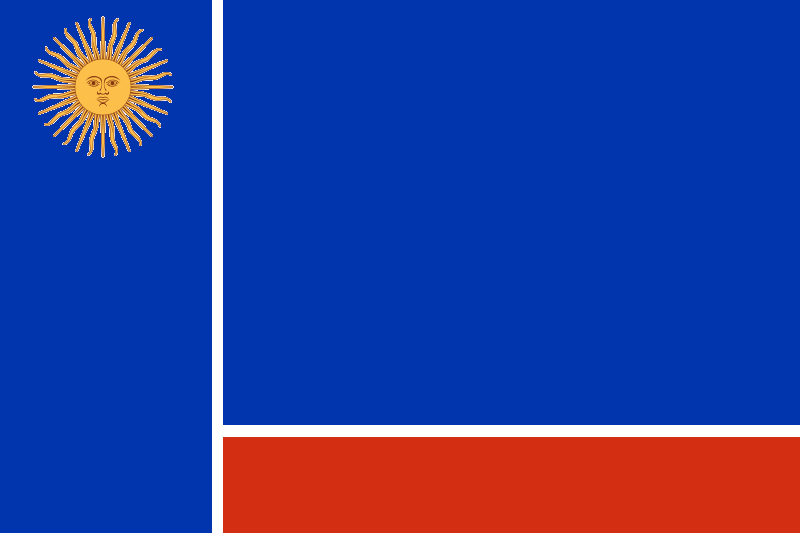
Flag of the Confederate States of Latin America
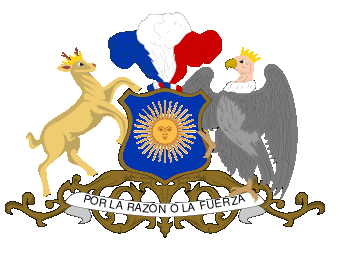
Coat of arms of the Confederate States of Latin America

Presidential Sash

Presidential Sash (worn by military dictators)
State Symbols
Argentina


Bolivia


Chile

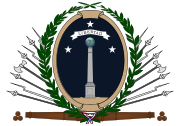
Colombia


Ecuador


Panama


Paraguay


Peru


Uruguay


| | |
|---|---|
| General: Confederate States of Latin America, Economy of the ECAL, Justice and Law in the ECAL, President Michelle Bachelet, Presidency | |
| Political: Partido Republicano Constitucional, Partido Laborista Socialista, Partido de la Democracia Cristiana | |
| Military: Fuerzas Armadas, Armada, Ejercito, Fuerza Aerea, Infanteria de Marina, Guardia Nacional | |
| Military Aircraft: FMA SAIAL 90, A-4AL Fightinghawk | |
| Armoured Vehicles: TLAM Medium Tank, TLAP Main Battle Tank | |
| Warships: Ship Profiles, Ardiente and Valeroso class destoyers | |
